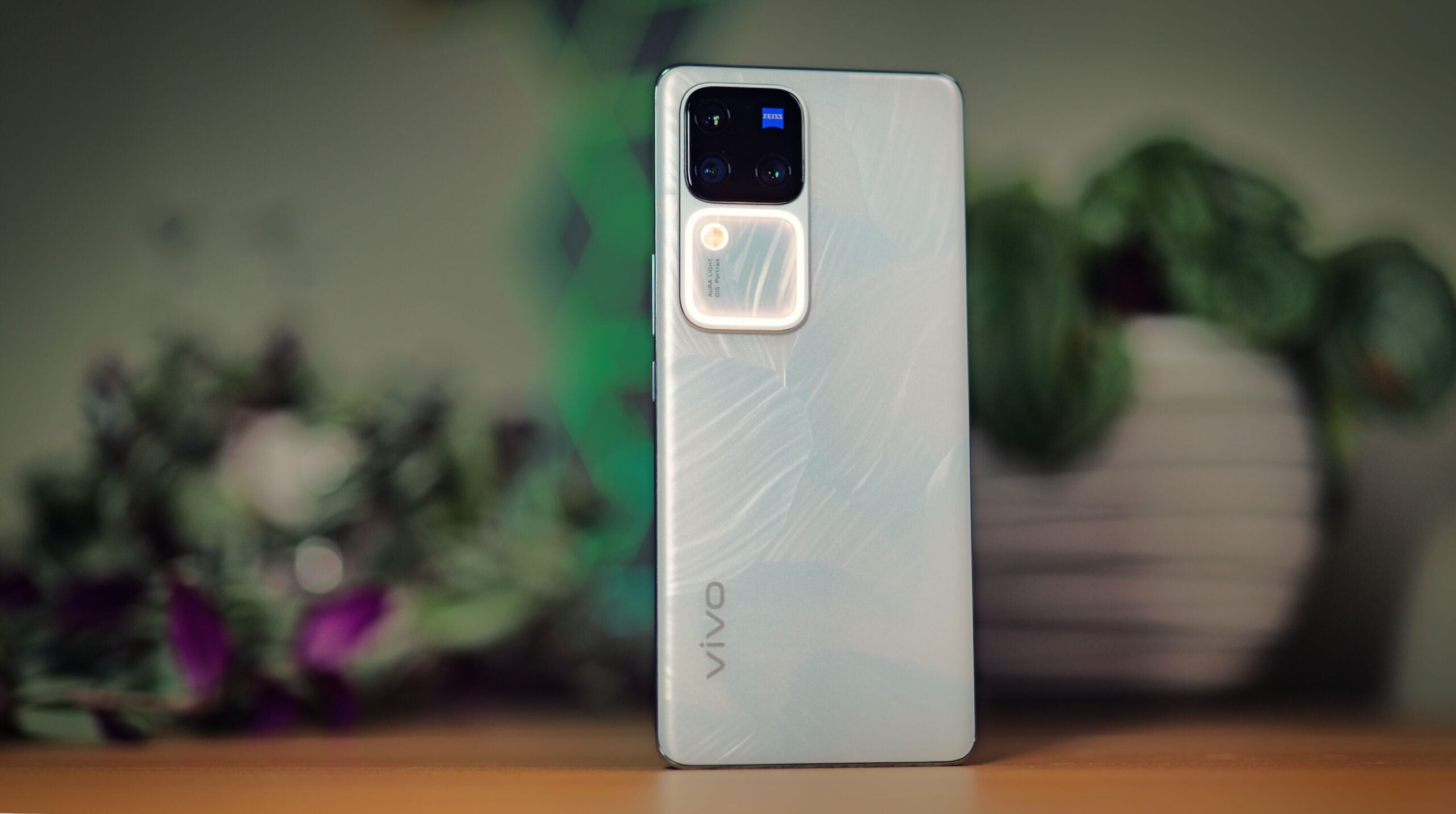Google Pixel 8 Review
An undeniably strong camera-focused smartphone with charming AI features and exceptional long-term software support.

Verdict
The design looks a bit dated, but the Pixel 8 otherwise represents a great buy with impressive camera performance, AI-infused features that remain unique amidst increased competition, and all-day battery life that makes it a joy to use.
Pros
- Impressive camera performance with unique AI features
- Solid 6.2-inch OLED display
- All-day battery life
- 7 years of OS upgrades
Cons
- Dated design
- No telephoto lens
- Raw performance is behind other flagships
Key Features
- Impressive camera capabilitiesThe Pixel 8 can capture some truly stunning images, packed with detail, vibrant colour and accurate skin tones, regardless of light conditions.
- Unique AI featuresFrom Android 14 features like Now Playing to photo and video editing features like Magic Audio Eraser, Magic Editor and Best Take, the Pixel 8 does things no other smartphone does.
- Exceptional long-term software supportGoogle’s new commitment of 7 years of OS upgrades is the best you’ll find on an Android smartphone, taking the Pixel 8 through to Android 21.
Introduction
Google’s flagship Pixel 8 may no longer be the only AI-infused flagship on the block with the introduction of the likes of the Galaxy S24 and Honor Magic 6 Pro in early 2024 – but it remains the most capable.
While I’m not personally a huge fan of the Pixel’s design, it’s hard to deny that Google has an impressive combination of hardware and AI-enhanced software on its hands with the Pixel 8.
It continues its journey of fixing long-time Pixel complaints with a jump to a 120Hz display and improved battery life while doubling down on its AI-powered camera and editing tech that makes the Pixel 8 one of the best camera phones at its price point, able to compete with flagships that cost a lot more.
Throw in impressive numbers like seven years of OS upgrades and you’ve got a very tempting Android smartphone.
Design
- Same design as Pixel 7
- Camera bar still protrudes pretty far
- Glossy or matte finishes
The Pixel 8 isn’t what I’d consider a redesign of the form factor – in fact, it looks near-identical to the Pixel 7, which in turn looks a lot like the Pixel 6. That is to say that the Pixel range has looked pretty much identical over the past few years, complete with the same thick rear camera bar, and I feel like it’s in need of a refresh.
Compared to exquisitely thin-and-light options like the Motorola Edge 40 or flush options like the iPhone 15, the Pixel 8 feels comparatively thick, measuring in at 8.9mm (not including the camera bar) and 187g respectively.
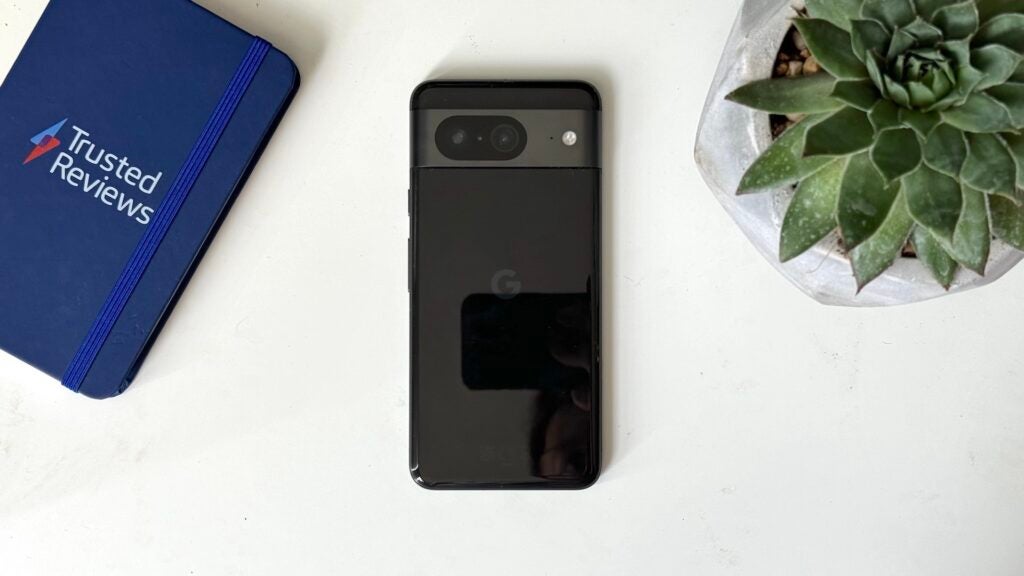
The metal and glass construction does help give the Pixel 8 a premium feel, IP68 protection is great to see, and the rounded edges certainly make the 6.2-inch smartphone nice to hold, but it just feels like a smartphone that’s a couple of years old. It’s fine, but it’s not exactly exciting.
Then there’s the famous (or should that be infamous?) camera bar, stretching across the entirety of the rear of the smartphone. It’s very much a Marmite feature that’ll split opinion, but I’m not a huge fan. The shelf above and below the camera bar, are absolute dust magnets, picking up pocket lint and other detritus in everyday use that can make it look messy.

I’ve also noticed that the camera bar protrudes far enough for it to snag on my jeans pocket as I pull it out – something that I’ve not really experienced with any other smartphone in recent times.
Elsewhere, the Pixel 8 continues Google’s trend of pastel-inspired finishes in the form of Hazel and Rose, along with a more understated Obsidian finish. However, unlike the matte-finish Pixel 8 Pro, the standard Pixel 8 sports a glossy rear, and that means, like its predecessor, it’s a fingerprint magnet. After just a few minutes of use, I was already wiping the smudged rear panel, and I haven’t really stopped since.
Of course, it may well be that you absolutely love the design of the Pixel 8 – design is relatively subjective, after all – but it’s not my favourite.
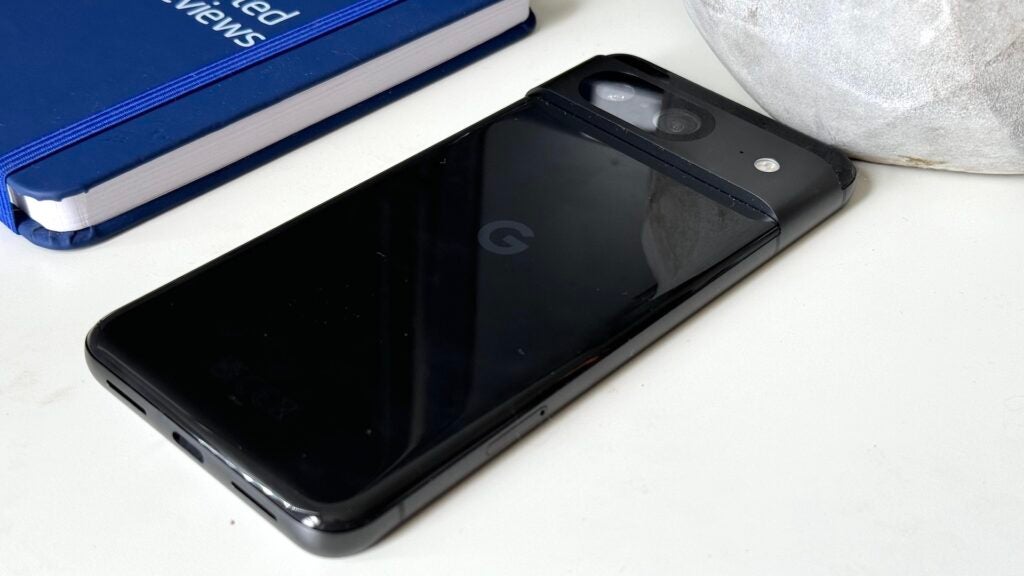
Screen
- 6.2-inch Actua display
- Fast 120Hz refresh rate
- Impressively bright
Google states that the Pixel 8 boasts a 6.2-inch Actua display – but what is that, exactly? Turns out that it’s simply a marketing term that refers to the brightness of the phone screen, which caps out at a rather impressive 1400nits in general use and a boosted 2000nits when watching HDR content.
It’s not the brightest on the market then, but it’s a significant improvement and more than bright enough for comfortable use in even direct sunlight, something I noticed on a rare sunny day in Blighty.
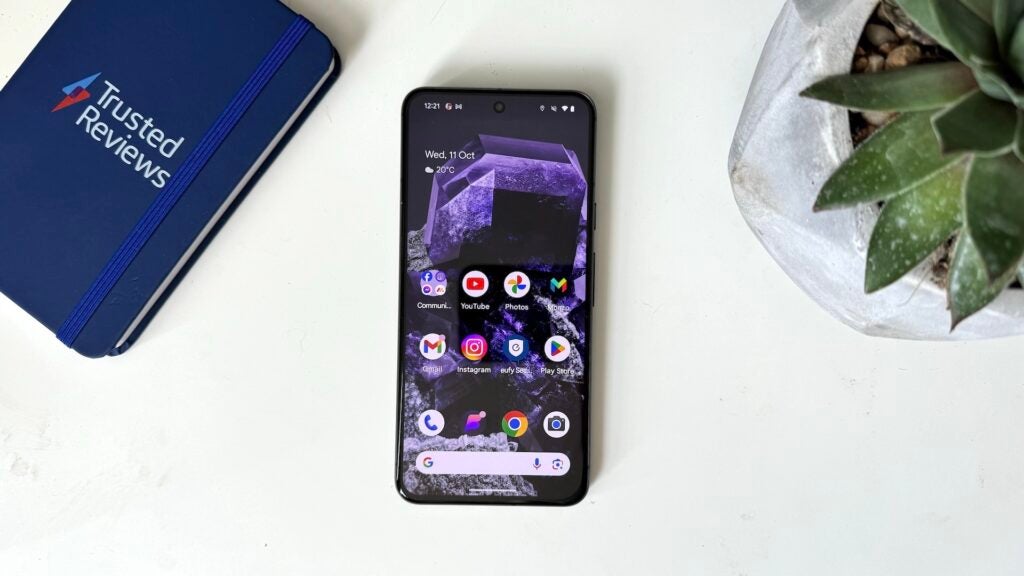
Instead, it’s an OLED panel powering the experience, meaning the blacks are inky and the colours are particularly vibrant. That makes for a great binge-watching experience, especially when it comes to colourful animated series’ like Futurama that pop on screen. It also supports HDR10+, with supported content delivering impressive dynamic range – an element further improved by Google’s Actua brightness tech.
The more astute Pixel fan may notice that the Pixel 8 is 0.1 inches smaller than its predecessor, but that’s not really that noticeable in real-world use. In fact, with the same 1080 x 2400 resolution as the Pixel 7, the Pixel 8 is more pixel-dense at 428ppi, and that is noticeable. The crisp look of the display was one of the first things I observed when powering it on.
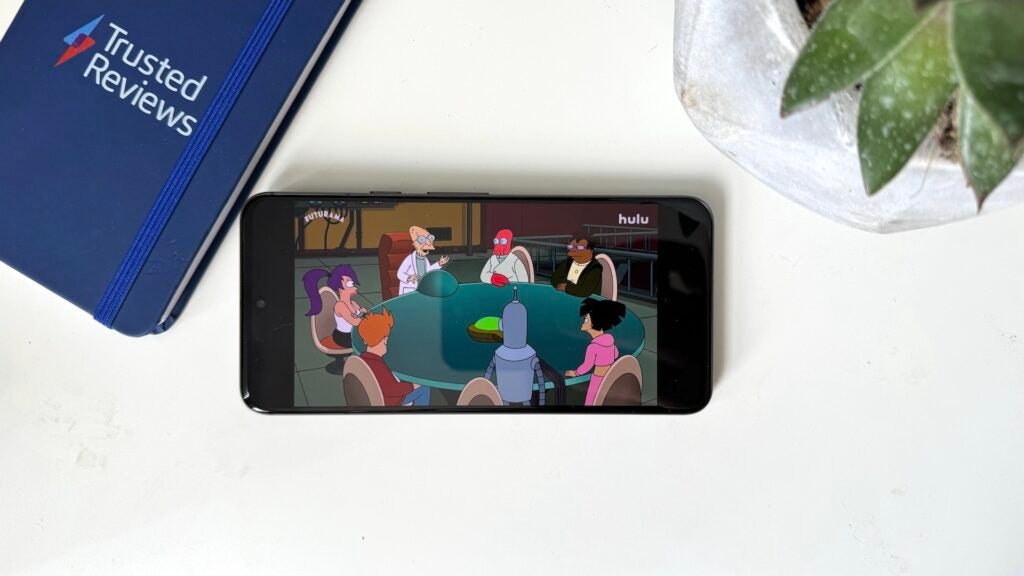
Google has also finally made the jump to the now-standard 120Hz refresh rate seen on much of the Android competition, up from the 90Hz of the Pixel 7, though it misses out on the LTPO tech of the Pixel 8 Pro.
Regardless, this allows the Pixel 8 to better compete in a busy premium space, and the super-smooth refresh rate makes animations, scrolling and anything with a bit of movement feel that little bit nicer.
Cameras
- 50MP main and 12MP ultrawide
- Impressive everyday performance
- Slew of unique AI capture and editing features
Google has a bit of a reputation when it comes to camera performance, with Pixels tending to produce some of the best imagery of any Android phone, arguably even eclipsing top-end options like the Samsung Galaxy S24 Ultra – and that, of course, continues with the Pixel 8.

The star of this year’s show is the new 50MP octa-PD main camera, with key specs including f/1.68 aperture and a 1/1.31-inch sensor. It’s also the same as the main camera of the more expensive Pixel 8 Pro, meaning you’re getting the best camera quality possible even with the cheaper model.
Instead, the main reason to opt for the Pixel 8 Pro is the inclusion of a 48MP 5x telephoto lens, allowing you to get closer to your subject – though with Google’s AI-powered 8x Super Res Zoom available, I’d argue that the lack of a dedicated telephoto lens on the regular Pixel 8 isn’t as big a dealbreaker as it would be on any other Android smartphone.
That all said, the Pixel 8 is capable of taking some truly stunning photos. Images in well-lit conditions are punchy while not looking overprocessed like some rivals, with plenty of detail and impressively accurate colours. That’s especially true of skin tones, with the Pixel 8 delivering some of the most true-to-life skin tones of any phone I’ve tested this year.
HDR performance is just as impressive, managing to capture a wide dynamic range without that washed-out look, even in harsh direct lighting.
Low-light photography is another strong point of the Pixel 8, delivering images packed with light and vibrant colours that make the London night cityscape look particularly tasty. There’s still the occasional lens flare where the source of light is directly in the image, but I’d say it adds to the overall look of the image, rather than detracting from it.
I will say, it performs best when there’s some light in the scene. When it comes to truly dark night conditions, the Pixel 8 falls behind what’s possible on rivals like the iPhone 15 Pro, so it’s not the perfect low-light option.

Alongside the main camera you’ll find a 12MP ultrawide with a wide 125-degree FOV that’s perfect for both scenic vistas and taking big group photos. Despite the lower resolution of the ultrawide lens, the quality of images is consistent between the two. It’s just as detailed and vibrant as what you’ll get from the main lens, with surprisingly consistent colour tuning between the two lenses. It’s not quite as capable in low-light conditions, however.
Of course, that’s only half the story when it comes to Pixel phones. The Pixel 8 continues Google’s journey of AI-infused photo and video features with new additions to the already-wide roster including Macro Focus, which can deliver enhanced detail in extreme close-ups. There’s also Video Boost that will automatically improve video quality, but that’s not available until later this year.

There are also new editing features available in the Google Photos app to complement the upgraded AI functionality. This includes pretty cool features like Audio Magic Eraser which removes annoying background noise like sirens from videos, and Best Take, which can essentially generate an image with everyone’s best smiles – no more silly poses ruining those precious group shots.
By far the coolest feature is Magic Editor, a new feature that uses generative AI to edit huge swathes of images. It’s similar to what Photoshop can do in the latest betas, and it works impressively well. It allowed me to completely remove all the cars from my road and even change the time of day, as seen below.
It also allowed me to completely remove some roadworks from an image with good (but not perfect) results.
The AI-infused editing will likely split opinion, but if you’re into that kind of thing, there’s no better phone for it than the Pixel 8. The Samsung Galaxy S24 comes closer than most alternatives with its Galaxy AI photo editing features that let you remove subjects and adjust the framing using generative fill, but it’s nowhere near as fully featured as the Pixel.
Performance
- New 4nm Tensor G3 chipset
- Everyday performance is responsive
- Not the best for gaming
The Pixel 8, along with the Pixel 8 Pro, are the first Pixels to sport Google’s upgraded 4nm Tensor G3 chipset.
The chipset continues the company’s focus on AI smarts over pure performance power with some pretty cool software features, like the camera tricks mentioned earlier, along with other cool features that I’ll come to in more detail in a bit. That’s paired with 8GB of LPDDR5X RAM and either 128- or 256GB of storage depending on the model you opt for.
I must admit, I was initially concerned about the general performance of the Pixel 8. The first couple of days of use were marred with stuttering, even when performing relatively simple tasks like scrolling through X and going to the Home screen. However, a subsequent software update seemed to fix the issue, and in the days since, I’ve not really noticed much of a slowdown.
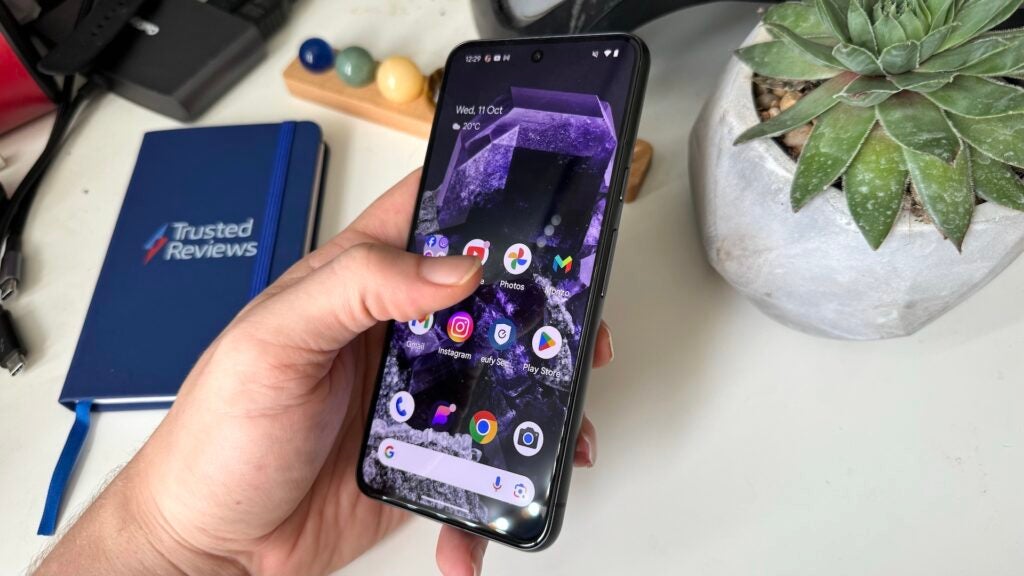
That means general performance is very responsive, with a smooth execution when scrolling through TikTok, messaging on Beeper and even when editing photos using the phone’s new AI features. The same can’t quite be said for gaming, however.
When playing a short 15-minute session of Survivor.io, a cartoon-y 2D top-down shooter, there were a few moments with drops in frame rate and even a bit of stuttering – and this is a game that generally runs quite well on even mid-range chipsets. It wasn’t consistently bad, but it happened when there were a lot of moving parts on screen.
That’s all backed up by benchmark results too; in terms of raw performance, the Tensor G3 is more in line with 2022’s Snapdragon 8 Plus Gen 1 than the newer Snapdragon 8 Gen 2 that alternatives were rocking at its initial launch in October, and that gap has only widened with the release of the Snapdragon 8 Gen 3 found on similarly priced alternatives in early 2024.
Software
- One of the first phones with Android 14
- Great AI-focused features
- Industry-leading seven years of OS upgrades
Software, along with camera performance, are the two big reasons to opt for the Pixel 8 over the slew of other smartphones on the market.
The Pixel 8 was the first smartphone on the market to run Android 14 at launch in October, and it comes with a few handy new features unique to the Pixel. One of the smallest yet handiest is Rules, essentially a feature that allows your phone to automatically change settings based on elements like what Wi-Fi network you’re connected to.
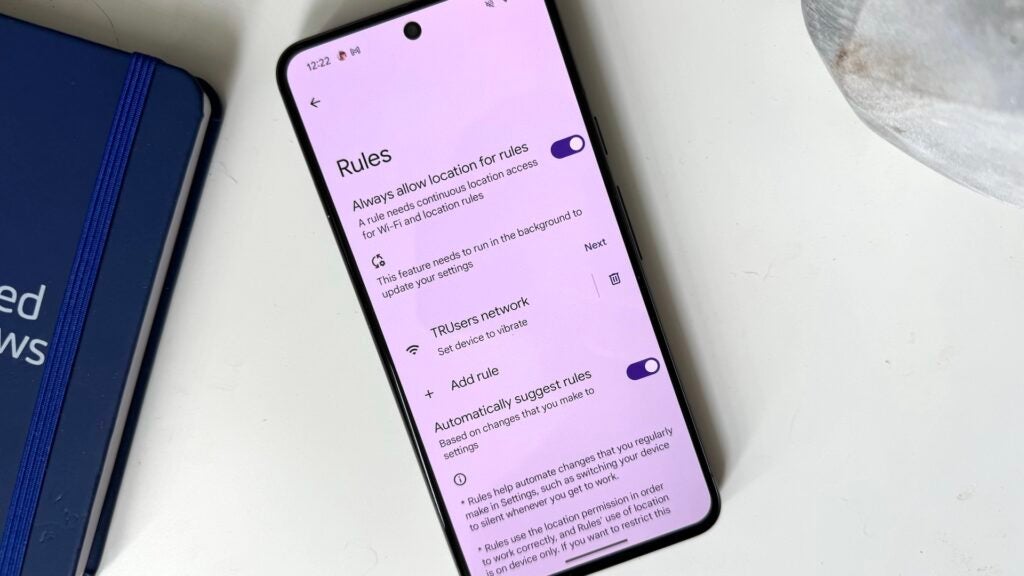
I set the Pixel 8 to set the phone to vibrate mode when connected to my work Wi-Fi, and now it’ll automatically quieten down in the office and then switch back to loud as soon as I leave. It’s small features like that that really make the Android 14 experience.
It’s also a clean interpretation of Android 14 with no custom UI elements or confusing Settings menus to navigate – a refreshing change compared to the bevvy of third-party Android skins like MIUI, ColorOS, FunTouchOS and MagicOS that heavily customise the experience on offer. That also means the Pixel 8 is completely free of bloatware, with only the standard Google apps appearing on the phone at setup.
It’s not just the clean approach to Android 14 that makes the Pixel 8 stand out. It also uses the advanced AI power of the Tensor G3 chipset to do some pretty cool things.
One of my favourites is the ability for the phone to automatically recognise background music as I go about my day, and it then lists this in a Now Playing app for me to browse later. It’s also absolutely incredible at voice-to-text translation and boasts unique Google Translate capabilities too – but there’s much more to it than big cool features.

Even smaller interactions, like being able to turn off my alarm and timers just by saying stop, and the AI-powered At a Glance that delivers much more contextual information than the standard widget available on most other Android smartphones, really enhance the experience of using the Pixel 8.
Samsung has begun encroaching on Google’s AI-infused OS with Galaxy AI on the new Samsung Galaxy S24 range, offering features like on-device translation, transcription, summarisation of text, changing the tone of emails and texts and basic photo editing tech, but it’s not quite up to Google’s standards – just yet, anyway.
But by far the best part about the Pixel 8 software experience is just how long it’ll be supported for, with Google committing to a market-leading seven OS upgrades and seven years of security patches that’ll take the Pixel 8 through to Android 21, matched only by Samsung with its S24 range. This means the Pixel 8 software experience will only continue to improve over time, with access to new features as Google reveals them.
Battery life
- 4575mAh battery
- All-day battery life
- Faster, but still relatively slow, 27W charging
The Pixel range has come a long way regarding battery life, especially compared to the dismal performance of the Pixel 4 back in 2019. Since that embarrassing affair, the Pixel range has consistently improved in the battery life department and, now with the release of the Pixel 8, I can honestly say that it’ll last all day without much of an issue.
That’s thanks to a combination of a power-efficient 4nm Tensor G3 chipset and a slightly boosted battery capacity, now clocking in at 4575mAh. That is still slightly behind the 5000mAh that’s seemingly becoming the standard in modern smartphones, but you won’t really be able to tell the difference in everyday use.

That said, I’ve found that the Pixel 8 can serve my needs on a long workday. That usually includes waking up at 7:30am, using it sporadically for texting, calls, replying to emails, taking a few snaps and having a cheeky scroll through TikTok, and by the end of the day at about 11:30pm, I’m looking at around 20-30% left in the tank.
For reference, that’s with around 3.5 hours of screen-on time on average, and plenty of screen-off time listening to music.
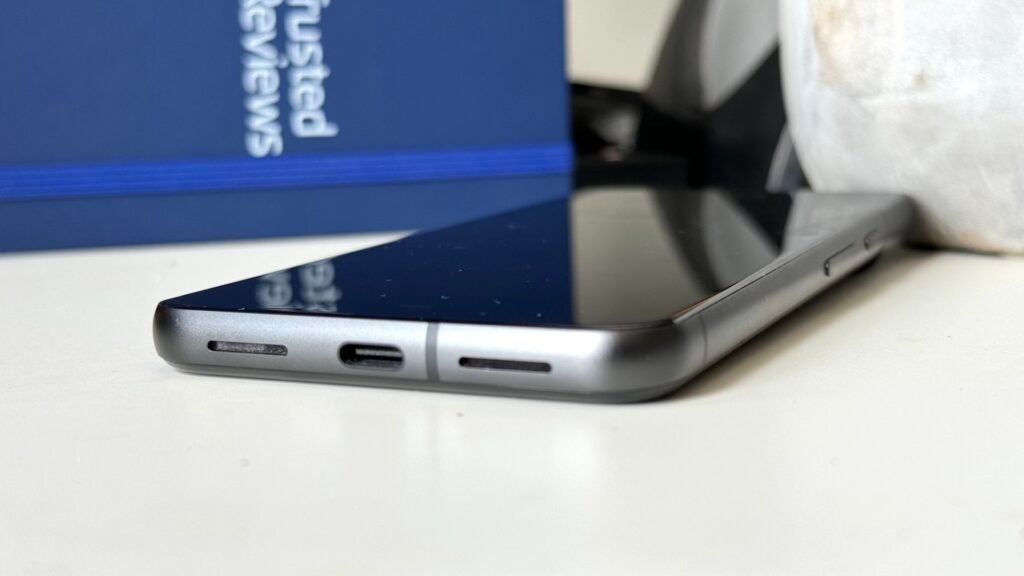
When it does need a top-up, the Pixel 8 charges faster than its 20W-enabled predecessor with (slightly boosted) 27W fast charge support. The problem is that there isn’t a charging brick included in the box, so you’ll need to source your own fast charger to experience those improved charging speeds.
More specifically, I saw 51% charge in 30 minutes with a full charge taking around an hour and 20 minutes. It’s not exactly the blisteringly fast speeds of the 120W Xiaomi 13T Pro, then, but it should slightly shorten how long your phone spends tethered to the wall.
You do also have the option of wireless charging, but at 18W, it’s notably slower than charging via the USB-C port.
Latest deals
Should you buy it?
You like to take a lot of photos
The Pixel 8 boasts a great camera setup, further enhanced by a slew of AI shooting modes and editing features.
You want the best performance possible
The Tensor G3 chipset prioritises AI capabilities over raw performance, meaning you’ll get better performance from Snapdragon 8 Gen 3-equipped flagship alternatives.
Final Thoughts
Marmite-like design choices aside, the Pixel 8 is a solid buy for anyone on the market for a great all-rounder in 2024. The 6.2-inch display is a big improvement on its predecessor with a max brightness of 2000nits, a faster 120Hz refresh rate and more pixels that translate to a gorgeous display well suited to gaming and binging.
There’s also solid everyday performance on offer from the AI-focused Tensor G3 chipset, though the gap in raw processing power is widening compared to competing Snapdragon 8 Gen 3 devices like the OnePlus 12 in early 2024. Still, it’s pretty power efficient, with the Pixel 8 not struggling to last all day on a single charge.
Of course, the big reason to opt for a Pixel is the camera, and it’s safe to say that the Pixel 8 delivers exquisitely detailed, vibrant and colourful images from its new main 50MP sensor. That extends to low light, though in truly dark settings, it does fall behind key rivals like the iPhone 15 Pro.
The new AI-infused shooting modes and photo editing features bolster Google’s AI-powered focus with some pretty cool tricks not available on any other smartphone. It won’t be for everyone, but if you like to edit your snaps before sharing on social media, the Pixel 8 is perfect.
Google’s clean approach to Android 14 is also ideal, with no bloatware and some genuinely helpful AI-powered features that are, again, exclusive to the Pixel 8.
The best part is that it’ll continue to improve for years with an industry-leading promise of 7 OS upgrades that’ll take the phone to Android 21. That’s only matched by Samsung with the Samsung Galaxy S24, and represents one of the big reasons to get yourself a Pixel.
How we test
We test every mobile phone we review thoroughly. We use industry-standard tests to compare features properly and we use the phone as our main device over the review period. We’ll always tell you what we find and we never, ever, accept money to review a product.
Find out more about how we test in our ethics policy.
Used as a main phone for a week
Thorough camera testing in a variety of conditions
Tested and benchmarked using respected industry tests and real-world data
FAQs
Yes, it can survive a dunk in water with IP68 dust and water resistance.
Despite the improved 27W charging speeds, the Pixel 8 doesn’t ship with a charging brick in the box – just a USB-C cable and a USB-C-to-USB-A adapter.


